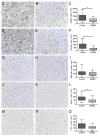An oral form of methylglyoxal-bis-guanylhydrazone reduces monocyte activation and traffic to the dorsal root ganglia in a primate model of HIV-peripheral neuropathy
- PMID: 28462488
- PMCID: PMC5623097
- DOI: 10.1007/s13365-017-0529-9
An oral form of methylglyoxal-bis-guanylhydrazone reduces monocyte activation and traffic to the dorsal root ganglia in a primate model of HIV-peripheral neuropathy
Abstract
Peripheral neuropathy (PN) is a major comorbidity of HIV infection that is caused in part by chronic immune activation. HIV-PN is associated with infiltration of monocytes/macrophages to the dorsal root ganglia (DRG) causing neuronal loss and formation of Nageotte nodules. Here, we used an oral form of methylglyoxal-bis-guanylhydrazone (MGBG), a polyamine biosynthesis inhibitor, to specifically reduce activation of myeloid cells. MGBG is selectively taken up by monocyte/macrophages in vitro and inhibits HIV p24 expression and DNA viral integration in macrophages. Here, MGBG was administered to nine SIV-infected, CD8-depleted rhesus macaques at 21 days post-infection (dpi). An additional nine SIV-infected, CD8-depleted rhesus macaques were used as untreated controls. Cell traffic to tissues was measured by in vivo BrdU pulse labeling. MGBG treatment significantly diminished DRG histopathology and reduced the number of CD68+ and CD163+ macrophages in DRG tissue. The number of recently trafficked BrdU+ cells in the DRG was significantly reduced with MGBG treatment. Despite diminished DRG pathology, intraepidermal nerve fiber density (IENFD) did not recover after treatment with MGBG. These data suggest that MGBG alleviated DRG pathology and inflammation.
Keywords: Dorsal root ganglia; HIV; Monocyte; Peripheral neuropathy; Polyamine biosynthesis inhibitor; Rhesus.
Conflict of interest statement
Conflicts of Interest
Michael McGrath is a shareholder and consultant in Pathologica, LLC. For the remaining authors, there are no conflicts of interests.
Figures



Similar articles
-
Monocyte Traffic, Dorsal Root Ganglion Histopathology, and Loss of Intraepidermal Nerve Fiber Density in SIV Peripheral Neuropathy.Am J Pathol. 2015 Jul;185(7):1912-23. doi: 10.1016/j.ajpath.2015.03.007. Epub 2015 May 5. Am J Pathol. 2015. PMID: 25956030 Free PMC article.
-
Loss of intraepidermal nerve fiber density during SIV peripheral neuropathy is mediated by monocyte activation and elevated monocyte chemotactic proteins.J Neuroinflammation. 2015 Dec 18;12:237. doi: 10.1186/s12974-015-0456-8. J Neuroinflammation. 2015. PMID: 26683323 Free PMC article.
-
α4-Integrin Antibody Treatment Blocks Monocyte/Macrophage Traffic to, Vascular Cell Adhesion Molecule-1 Expression in, and Pathology of the Dorsal Root Ganglia in an SIV Macaque Model of HIV-Peripheral Neuropathy.Am J Pathol. 2016 Jul;186(7):1754-1761. doi: 10.1016/j.ajpath.2016.03.007. Epub 2016 May 6. Am J Pathol. 2016. PMID: 27157989 Free PMC article.
-
An SIV macaque model of SIV and HAND: the need for adjunctive therapies in HIV that target activated monocytes and macrophages.J Neurovirol. 2018 Apr;24(2):213-219. doi: 10.1007/s13365-018-0616-6. Epub 2018 Feb 12. J Neurovirol. 2018. PMID: 29435829 Review.
-
Monocyte/macrophages and their role in HIV neuropathogenesis.Immunol Rev. 2013 Jul;254(1):102-13. doi: 10.1111/imr.12068. Immunol Rev. 2013. PMID: 23772617 Free PMC article. Review.
Cited by
-
Nageotte nodules in human DRG reveal neurodegeneration in painful diabetic neuropathy.Res Sq [Preprint]. 2024 Sep 27:rs.3.rs-5006011. doi: 10.21203/rs.3.rs-5006011/v1. Res Sq. 2024. Update in: Nat Commun. 2025 May 5;16(1):4168. doi: 10.1038/s41467-025-59538-z. PMID: 39399674 Free PMC article. Updated. Preprint.
-
Nageotte nodules in human DRG reveal neurodegeneration in painful diabetic neuropathy.bioRxiv [Preprint]. 2024 Aug 23:2024.08.22.609215. doi: 10.1101/2024.08.22.609215. bioRxiv. 2024. Update in: Nat Commun. 2025 May 5;16(1):4168. doi: 10.1038/s41467-025-59538-z. PMID: 39229145 Free PMC article. Updated. Preprint.
-
Methylglyoxal-bis-guanylhydrazone inhibits osteopontin expression and differentiation in cultured human monocytes.PLoS One. 2018 Mar 14;13(3):e0192680. doi: 10.1371/journal.pone.0192680. eCollection 2018. PLoS One. 2018. PMID: 29538412 Free PMC article.
-
Atrophy and Death of Nonpeptidergic and Peptidergic Nociceptive Neurons in SIV Infection.Am J Pathol. 2020 Jul;190(7):1530-1544. doi: 10.1016/j.ajpath.2020.03.004. Epub 2020 Apr 1. Am J Pathol. 2020. PMID: 32246920 Free PMC article.
-
Update of HIV-Associated Sensory Neuropathies.Curr Treat Options Neurol. 2017 Aug 31;19(10):36. doi: 10.1007/s11940-017-0472-3. Curr Treat Options Neurol. 2017. PMID: 28861848 Review.
References
Publication types
MeSH terms
Substances
Grants and funding
LinkOut - more resources
Full Text Sources
Other Literature Sources
Medical
Research Materials
Miscellaneous

